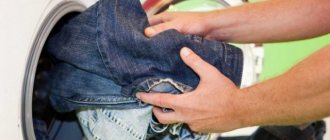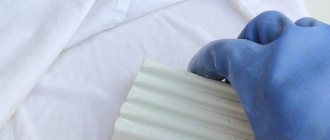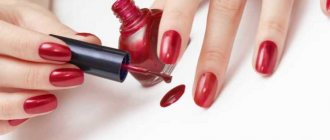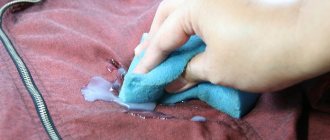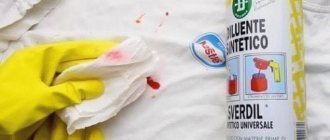Wine stains are considered one of the most difficult stains to wash. The drink contains components that, over time, are deeply absorbed into the material and remain there for a long time, if not forever, especially if the stain is not washed off immediately after application. Under the influence of the sun and oxygen, it turns into a global problem.
Any contamination should be removed immediately, otherwise more effort will be needed when washing with each passing hour. But during holidays and friendly gatherings, it is impossible to keep an eye on everything. Drops on a blouse, carpet or tablecloth are common. If you have such a problem, then the need to remove the wine stain arises by itself.
Recommendations for removing stains
High-quality powders and stain removers do not always cope with complex stains, such as wine stains, for example. Often, improvised means that the housewife doesn’t even know about help to wash them.
Before you start cleaning clothes from wine stains, you should follow some rules and recommendations:
- before applying the product to the stain, check how your material reacts to it by dropping it onto an inconspicuous area of clothing;
- if you stain your jacket, you should tear off the lining, as a wine mark may be imprinted on it;
- when you want to wash only a stain and not the entire thing, you should place a well-absorbent fabric underneath;
- It is best to carry out local cleaning in a circular motion from the edge to the center and change the cloth or sponge as soon as they become dirty, so as not to leave associated marks on other places of clothing;
- if you work with chemicals, use gloves;
- When applying various alcohols to fabric, be sure to open the windows.
If you are wondering how to remove red wine from clothes, try different types of salt, soda, various alcohols, lemon, peroxide.
Each of these elements can harm your item if used incorrectly. Be careful not to deviate from stain removal instructions and do not apply large amounts of mixtures.
Good to know
Before using any of the above products, thoroughly blot the contaminated area with a clean napkin or piece of paper.
Prepare a suitable mixture. To do this, you can use any stain remover, simple washing powder, dishwashing liquid and even laundry soap. Mix 1 tsp. l of the selected product with 1 glass of peroxide solution.
Dampen the sponge in the prepared product and treat the stain (from the edges to the center). Before doing this, do not forget to place a clean cloth under the contaminated area so as not to stain anything in the house.
For machine washable clothes, wash them in cool water. If the fabric can only be washed by hand, then use cold water.
Removing fresh drink stains
If you notice contamination in time, it will be much easier to deal with it. As soon as you see a stain, take immediate action. To do this, you will need to head to the kitchen and prepare all the necessary components:
- Hot water. A fresh stain can be easily removed if you pour plenty of boiling water on it. Place the stain under running hot water and wipe with a clean cloth. After some time, the contamination should come off.
- Salt. Wet the dirty area with warm water, sprinkle salt on top and rub thoroughly with a cloth. You will see the spice crystals absorb the dye. If the stain is too large, remove the colored salt and apply clean salt again. Then rinse the item in cold water.
- Wet wipes. A small stain can be blotted on both sides with a regular damp cloth.
- Lemon. Cut a piece of lemon and rub it on the stain. If the fruit is not at hand, citric acid will do. Sprinkle it on the damp, dirty area and leave for 10 minutes. Then remove the lemon powder using water.
- Ammonia. Blot the stain with a dry cloth to absorb any liquid from the surface. Dilute ammonia with water and moisten a cotton pad with it. Wipe the stain with the resulting solution until the stain completely disappears.
- Laundry soap. Wash the item or wine stain in warm water using laundry soap. Then rinse in cold water.
- Table vinegar. Use a dry cloth to remove any remaining wine on clothing, then apply a couple of drops of 9% table vinegar to the stain. You can use cotton wool. The item must be left for a few minutes for the acid to take effect.
- Vodka and glycerin. Mix both substances in a 1:1 ratio, apply them to a dry cloth and wipe the stain. For the best effect, you need to leave the treated area for 10-15 minutes. Then rinse with cold water.
- Potassium permanganate. It fights well against stubborn stains on clothes. Dilute potassium permanganate in water and apply it to the spot using cotton wool. Then wipe it with peroxide and wash it with powder.
- White wine. As strange as it may sound, white wine will help remove a red wine stain. Pour white wine onto the fresh “blot” and wipe with a clean, dry cloth.
- Ice. Rub the fresh mark with a piece of ice and remove any excess with a dry cloth.
What to do when a stain appears?
So you're sitting at the table and someone accidentally spills red wine on you. What to do? You won’t be taking off your soiled dress and doing laundry in the midst of the holiday, especially since you can relax not at home, but at someone’s house. The main thing is not to get confused. First of all, take a few napkins (as a rule, napkins are placed on the festive table so that guests can wipe their hands) and blot the stain thoroughly with them. After this, at home it will be much easier for you to deal with the task.
But if suddenly you see that all the guests are busy with their own affairs, then (after you have already dried the stain a little) take a couple more napkins from the table, a small bowl of salt and head to the bathroom. Pour cold water into a container with salt until you get a paste. Apply it to the contaminated area and rub thoroughly. This can be done without even removing the dress, unless, of course, the stain was placed on the back. After the first procedure, there may be nothing left of the stain. As soon as the salt absorbs the wine, remove it with napkins or a brush. That's all. Now you can safely return to your guests and continue to have fun, only more carefully.
When you get home, wash the item in cold water, adding ammonia (1 teaspoon of alcohol per liter of water). Then, repeat the wash, only in warm water with a simple powder. Please note that you should not immediately wash clothes in hot water, as the stain may change its color to blue or purple. Then it will be more difficult to cope with the task.
How to remove an old stain
There are many recipes to remove red wine stains. Old pollution does not succumb to them. Cleaning outdated stains requires more strength, energy and effective mixtures. They mainly consist of aggressive components that can harm your tissue. Therefore, use them with caution when washing colored and delicate items.
Hydrogen peroxide works well on stains on white fabrics. Peroxide works not only as a stain remover, but also as a bleach:
- It is necessary to prepare a mixture of peroxide, ammonia and water, mixing them in equal proportions.
- Soak a cotton swab in this solution and rub the stain in a circular motion.
- Leave the item for a while so that the components can take effect.
- Then rinse the fabric thoroughly under running water.
How to remove fresh and old wine stains without going to the dry cleaner?
Often, after festive events or friendly gatherings, situations arise when it is necessary to remove a wine stain that has formed on a tablecloth or clothing. Those who have already found themselves in a similar situation know very well how difficult such a task is. This is explained by the fact that wine contains natural coloring pigments that penetrate deeply into the fabric structure and change its color not at the surface level, but at the fiber level. Even commonly available products available in almost every home can effectively remove wine stains; the main thing is to know how to use them correctly in such situations.
Removing stains from various types of fabric
Some types of fabrics require special attention and care. Some of them cannot be washed, some cannot be cleaned with chemicals. Always check the labels on your clothing. They contain all the information about clothing care:
- Dairy products are suitable for cleaning woolen items. Treat the wine trail with warm milk or kefir and leave for 20-30 minutes. Then remove the components from the surface of the product with a damp cloth and wipe with a dry cloth.
- Soda is suitable for cotton tablecloths. It must be diluted in water and applied to contaminated areas. Leave for a while, then wash the fabric.
- Housewives prefer to clean colored items with an egg mixture. Mix an egg yolk with 2 drops of glycerin and treat the stain. Then wash the item in cold water.
- Removing stains from silk requires a special approach. The fabric is quite delicate and needs attention. Housewives always use glycerin and wine vinegar when making this fabric. They clean dirt well and do not harm the material.
- Sodium hydrosulfite will help wash a white blouse or T-shirt. It is applied to the dirty surface and left for 20 minutes. Then wipe with a cloth soaked in warm water.
- Synthetic items are washed using a mixture of liquid soap and alcohol. Mix the ingredients in a 1:1 ratio. Moisten the sponge with the resulting solution, then rub it into the fabric and rinse in cool water.
- Clothes made from linen are cleaned with peroxide, but if this does not help, then the item must be boiled. Pour 2 liters of water into a saucepan and put on fire. When the water boils, add 2 tablespoons of grated laundry soap and the same amount of soda. Place the item in there and turn down the heat. Boil for 2 hours, constantly checking with a wooden spoon so that it does not burn.
- Boiling water will help remove stains from jeans. Dilute a spoonful of table vinegar and citric acid in a glass of hot water. Pour the solution onto the stain and soak for 10 minutes. Blot the residue with a napkin and wash the clothes.
How to remove wine stains from a sofa using citric acid and juice?
Citric acid and freshly squeezed lemon juice are excellent for removing stains caused by upholstery contact with red wine. A solution made from citric acid has a less aggressive effect than undiluted citrus juice:
- add 1 tsp. citric acid in 100 ml of water at room temperature;
- mix the solution, pour it into a spray bottle;
- Apply the product to the upholstery, leave for 5-7 minutes, then remove with a soft, damp sponge.
Old stains can be wiped off with undiluted lemon juice, but this method is more suitable for light-colored upholstery, because the juice discolors the material.
Cleaning interior items
It is more difficult to remove red wine from carpet and furniture than to wash it from clothes, since they cannot simply be put in the washing machine and washed. In addition, the material for these products can be more picky.
The first action when spilling a drink on furniture should be to try to remove the stain with napkins. If that doesn't work, sprinkle some fine salt on top. But, unfortunately, even after timely procedures, a trace of wine may remain on the sofa. To remove it, you need to wipe the surface with a solution of vinegar and detergent in a 1:1 ratio.
You can clean the carpet with a brush using a stain remover, or if the carpet is white, use bleach. Only then will you have to wash the entire surface of the carpet, and not just the area on which the drink was spilled.
A 1:1 mixture of ammonia and glycerin will help remove stubborn red wine stains from the sofa. Use cotton wool to wipe the upholstery with this solution until the stain disappears. When soiled, it is necessary to change the cotton wool . Then go over with a cloth dampened with cool water.
You don't have to buy expensive detergents to remove red wine stains. It is enough to be smart and use traditional methods. They are not only easy to use, but also proven over the years, so they will never let you down.
Delicate fabrics (silk, nylon, nylon)
Even fresh traces of wine from such delicate materials as silk, nylon and nylon are more difficult to remove than from cotton and linen. You can try to cope with getting rid of traces of wine spilled on the material in one of the following ways:
- Removing fresh wine stains using an acetic acid solution. The concentration of acetic acid in the solution used to clean delicate fabrics should be slightly higher than for cotton and linen materials. The prepared solution is used to treat the stain several times to achieve maximum lightening.
- Using a solution of liquid soap and alcohol . Having prepared a solution of a small amount of liquid soap and alcohol, they should treat the material with the wine stain, using a cotton swab or sponge for this purpose. After performing this treatment, it is necessary to rinse the product in clean water.
Why are wine stains so difficult to remove?
The color of the wine depends on the grape variety. Anthocyanins, substances concentrated in the skin of the berries, give the drinks their bright red tints. These pigments are extremely durable and cannot be removed with alkali or alcohol-based solvents. Vegetable dye molecules penetrate deeply into the fabric and are absorbed into the fibers.
The process is aggravated by tannins, which all wines are rich in. One of them is tannin, which is similar in action to acids. The substance, remaining on the fabric for a long time, partially destroys its top layer, facilitating the penetration of pigment.
If you spill wine on clothes, tablecloths or furniture, it is important to begin eliminating the stain as quickly as possible. In this case, the chances of getting rid of it will be much greater.
Some useful tips
When cleaning fabrics from traces of wine, you should follow a few simple recommendations, which are as follows:
- Before you begin to get rid of a fresh wine stain, you should blot it dry with a clean napkin;
- treating the stain with a cleaning solution should be done from its edges to the center;
- The fabric to be cleaned should be placed on a flat, hard surface covered with white material;
- To prevent a halo from forming around the wine stain when it dissolves, the area of fabric around it should be pre-moistened with water.
- The fabric, previously cleaned from stains, should then be washed in cold water.
By following these simple rules, you will make the process of getting rid of wine stains more effective.
Tea, coffee, chocolate
A soap solution will help clean the sofa from stains. Dampen the stain with a damp sponge, then rub it thoroughly with laundry soap. Using a brush (preferably with soft bristles), rub the soap into the upholstery using circular motions. Let it dry for 15 minutes. At the end of the specified time, remove any remaining soap with warm water. Dry the material with a hairdryer or paper towels.
Coffee stains can be removed using detergent - dilute a few drops in one liter of water, add 2 tsp. vinegar. Wipe the stained area with soapy water, then with a clean damp cloth and leave until completely dry.
Remove chocolate stains only after they have dried. Wash them with warm soapy water and dry with a soft towel.
Can tea be washed out of clothes?
Every tea lover knows the problem of unsightly brown marks on the inside of the cup. If the coloring substances of the drink are able to penetrate into the top layer of ceramics and glass, what can we say about fabrics: tea leaves very “corrosive” and difficult to remove stains on clothes.
The culprit is tannins – tannins, a large amount of which is found in tea leaves. Tannins quickly stain the fibers of fabric or paper, but removing brown pigment from a soiled item will not be easy - the molecules are hidden deep in the structure of the material.
Comment! Traces from light green tea are even more difficult to remove than from black tea. The reason for this strangeness lies in the same tannins: green tea leaves contain several times more tannins.
Having spilled their favorite drink on a blouse, jeans, tablecloth or sofa, many immediately part with the item. Don't rush - you can fight tea stains. Fresh marks are washed off much easier. The simplest case is newly “planted” tea stains on a white plain item. But you can also try to remove old tea stains. There are several truly effective ways to combat stains even on colored and synthetic clothing.
Dealing with traces of wine: common mistakes
When fighting pollution, it is important to avoid the following incorrect actions:
- Use aggressive cleaning agents to clean items made from delicate fabrics. Delicate matter can simply dissolve when exposed to an aggressive substance. It is not recommended to use chlorine-containing substances, recipes with turpentine, citric acid for washing silk blouses or natural wool carpets.
- Apply the stain remover immediately at the site of contamination. If possible, the stain should be thoroughly soaked in water so that it does not dry out, and in the meantime, test the effect of the substance in some inconspicuous place.
- Rub the stain with a dry cloth. If you start rubbing the stain, it will spread across the surface and become deeper.
- Procrastinate with removal. As soon as the wine has spilled, you should cover the stain as quickly as possible so that it does not spread. Then you need to find something that will be convenient to remove the red wine stain.
When fighting a stain, you can resort to different means. It may not be possible to completely remove an ugly blot. In this case, you should contact specialists. Modern dry cleaners are able to destroy even very stubborn stains and restore freshness to soiled items, so you shouldn’t waste money on this.
Website www.sympaty.net – Beautiful and Successful. Author – Rybak Elena Nikolaevna. More information about the site's authors
... and boiling water
This method is only suitable at home and provided that the tag of your product does not say that washing is allowed only in cool or cold water. If the clothes can withstand hot temperatures, then let's get started. Quickly place the kettle on the stove. While the water is heating up, take some container and place the soiled item so that the stain is under a stream of “running” water. This is necessary so that you can pour boiling water on the dirt without scalding your fingers. You can ask someone to help. So, water the stain until it disappears. Then we carefully take the item out of the basin so as not to get burned, and put it in the machine.
Vanish is a universal remedy
Vanish is a universal stain remover that comes in many varieties and removes even problematic drinks from sofa upholstery such as wine and coffee.
- Powders. Directions for use: dilute in water, soak a cloth in it and wipe the dirty area of the sofa.
- Gels. Like powders, gels work well on stains on sofa fabric, but act faster. Even old and stubborn stains are gently destroyed.
Directions for use: Apply a small amount of gel to fabric upholstery and wipe thoroughly, first with a dry cloth, then with a damp cloth. Spray. It will help reduce the strength of the molecules of a product or liquid that gets onto the sofa. Vanish spray is practically useless on old stains, so it is immediately applied to the dirty area of upholstery within a few minutes.
If a stain appears, apply a spray to it, let it sit for a few minutes, and then wash off with a wet household rag.
How to remove red wine from white and colored fabrics: effective methods
A stubborn stain is more difficult to remove than a fresh one, so you need to start removing it as soon as possible. First of all, try to eliminate the problem immediately and prevent the liquid from being absorbed into the fabric.
How to correctly:
- move from the edges of the spot to the center;
- monitor divorces;
- moisten the area around with clean water;
- select chemicals in full accordance with the type of fabric!
If the recommendations are not followed, the annoying mistake will leave a long memory, so we write down and save the most effective removal methods, and select the most appropriate one according to the situation.
Express methods for removing wine stains
As soon as the noble drink splashes out of the glass onto your dress or trousers, the minutes count.
- Immediately fill with mineral water, which will prevent absorption.
- Cover with a thick layer of regular table salt. An iodized version is suitable. It absorbs moisture and prevents pigment from penetrating into the fiber structure of the fabric. Upon returning home, the clothes are soaked for a couple of hours and washed as usual with washing powder.
- Do not allow the liquid to be absorbed! At least blot with a paper towel and moisten the top with water at room temperature.
- You can take the drastic method and pour white wine on top. Alcohol at room temperature removes coloring substances. Vodka is an option, since it is not colored in any way and cannot aggravate the situation.
If you suddenly have an express stain remover at hand, then apply it, but chemistry often harms materials. Many fabrics that require careful handling lose their attractive appearance.
How to wash wine on white
Among folk remedies, simple and cheap recipes have been accumulated for preserving the snow-whiteness of the material. The components can be found in any home, and the composition does not harm the structure.
- Vodka, glycerin and ammonia are mixed in a ratio of 3:1:1. The mixture is applied for 2-3 hours. The method is effective, but aromatic, and is carried out in a ventilated area or outdoors.
- Dilute half a teaspoon of citric acid in a glass of water, moisten a cotton pad with the solution and wipe off the stain. After 10-20 minutes you can wash it.
- Make a paste from baking soda. The consistency should resemble thick sour cream. It is applied to the stains and left until completely dry, removed when a crust forms.
- For 1 liter of water take 1 tbsp. l. alcohol or vodka, add laundry soap. It can be grated or taken in liquid form; the second option is preferable, because it dissolves faster. The damaged item is soaked in the resulting solution for half an hour. Or the mixture is poured into a spray bottle and applied only to the stain. The holding time is half an hour, then the normal washing mode starts.
- Wipe the dirty area with a sponge and colorless dishwashing detergent. Then soak a cotton pad in hydrogen peroxide and remove the product. Finally, rinse thoroughly.
Careful use of oxygen bleaches or stain removers is allowed. For example, apply regular Domestos to a sponge, soak it in water and quickly clean the stain, and then rinse off under pressure.
How to remove stains from colored clothes
To remove red wine from dyed fabric, you will need other methods:
- Glycerin and vinegar are taken in 1:1 proportions and applied to the problem. After a couple of hours, rinse.
- Glycerin and egg yolk are mixed 1:1 and applied in a thick layer for 4-5 hours. Machine washable in full cycle.
- Moisten with a pale pink solution of potassium permanganate, remove the residue with cotton wool soaked in peroxide.
- Heat and apply yogurt, leave for 1-2 hours. Wash. An excellent method for natural fabrics.
- Stain removers help a lot. Manufacturers produce universal products that do not harm colored fabrics. For example, wash with Antipyatin.
- Antipyatin and other stain removers are able to cope with this kind of stains. You just need to rub the product with soap or apply gel, and then rinse in warm water.
All products are time-tested and effectively remove even the smallest stains, without allowing trouble to spoil your mood and expensive item.
We clean without leaving the room
Cleaning a carpet in a room does not imply a thorough wash, since it is simply not possible to completely wash it at home on the floor without unpleasant consequences.
Firstly, due to the fact that it simply will not dry out and there is a huge risk of ruining the floor covering, especially if it is laminate or parquet.
In addition, there is a risk of flooding your neighbors. You cannot completely wash a carpet on the floor at home, but you can wash out individual stains.
For wet cleaning of rugs on the floor, a washing vacuum cleaner is ideal; it can easily clean out the most problematic dirt and absorbs up to 90% of the liquid.
Dry cleaning
One of the easiest products to use for cleaning products is regular table salt. For this method, the salt must be evenly distributed over the entire surface of the rug and rubbed with a brush until the grains of the product begin to darken.
The salt thus absorbs all the dirt. After this procedure, you just need to walk through the carpet with a vacuum cleaner. This method removes dirt well.
The second method is cleaning with baking soda. The algorithm of actions here is the same as with salt with only one difference - after you rub the carpet with a brush until the soda darkens, leave the carpet for 5-10 minutes and only then vacuum it.
There are other dry methods for cleaning rugs. As we already mentioned, it can be put in order using, for example, a special powder or foam. Each manufacturer has its own instructions, but the options are almost the same.
As a rule, it is recommended to distribute the product over the surface of the contaminated area, gently rub it into the pile and leave for about 1.5-2 hours, then the rug can be vacuumed. However, when using foam, damp spots may remain on the carpet; they need to be dried with a hairdryer.
All of the above methods are suitable for light cleaning with minor stains; they are not suitable for stubborn and old stains.
Wet cleaning
For more difficult stains, you should resort to wet cleaning. If we clean the carpet with salt, then for this we will need a kilogram of ordinary table salt and the juice of one lemon.
They must be mixed until a homogeneous mass is obtained, then, spreading the mixture over the surface, leave for 20 minutes.
At the end of the procedure, sweep away the mixture with a broom previously soaked in hot soapy water. After this, the carpet can be dried with a hairdryer.
In this case, 10-15 grams of powder are dissolved in one liter of water and a tablespoon of salt is added.
Before use, the mixture must be thoroughly mixed until a homogeneous mass is obtained. Then we take a brush and, periodically dipping it into the resulting solution, remove dirt from the carpet.
With this cleaning method, wet spots will remain on the rug. We get rid of them using a hairdryer.
Table vinegar
Table vinegar removes stains well. By the way, it also eliminates unpleasant odors. The method of preparing the solution is not complicated - you need to dissolve a tablespoon of vinegar in a liter of water. Then we take a medium-hard brush and, dipping it into the resulting solution, removing excess moisture on the sides of the container, gently scrub off the stains.
Baking soda
The flooring can be cleaned with a mixture prepared from 0.25 cups of baking soda and three liters of water.
For convenience, thoroughly mixed liquid can be poured into a spray bottle and sprayed over the surface of the contamination. Then let the liquid soak for half an hour and after that the carpet can be vacuumed.
Tea brewing
Tea leaves also clean stains well
It doesn’t matter whether it was green or black tea. The only important thing is that this cleaning method is suitable for dark-colored floor coverings
However, collecting the required amount of tea leaves is quite troublesome.
Moreover, the tea leaves need to be dried and stored in a cool, dry place so that it does not become moldy. But if this does not stop you, then fill the prepared tea leaves with water, preferably warm, and squeeze.
Then spread it over the surface of the floor covering and leave the tea leaves for half an hour. After this, it must be removed using a damp broom or vacuum cleaner.




